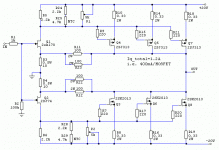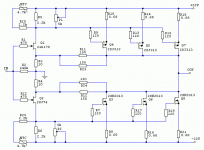For some reason, there is always a nice selection on eBay for less than $100.
Paid $60.
vicor pu33 | eBay
Paid $60.
vicor pu33 | eBay
We surely don't have same criteria about "cheap" 😀
Your link shows flatpack SMPS 24V/200W with a 1 unit price set at $307 and 2 x 24V/2 x 200W dual output unit costs $567. That amount of money buys a couple of great linear PSUs ...
Last edited:
Thank you! Got the case on Ebay. Worked out pretty well, except the heat sinks had a rough surface for mounting the transistors. Had to do some serious lapping. Also, replaced the top panel with perf to get some air in there.
Very nice build Anchan and I really like the look of your amp !
You let the cat out of the bag! ...although I've mentioned them before here, and there were no takers on the idea.
Vicor doesn't spec the switching frequency, just that it increases with load - up to 1MHz. Load that sucker! 🙂 I've looked at their output and I agree with you. You can easily trim the voltage down (and up slightly) too, with an equal loss of efficiency.
My only reservation is - if one dies (either the + or -) you're probably going to cook your speakers. this would be much less likely with a linear PSU (<edit: I see you're already concerned, i like the relay solution) You might want to put a bolt through the center hole in the SMPS. I believe they use the mounting for dissipation.
Last edited:
Which version has the dual o/p [+24v/0v & -24v/0v] option in the 200W range?
The 'specs' are not clear at all about this
The 'specs' are not clear at all about this
Which version has the dual o/p [+24v/0v & -24v/0v] option in the 200W range?
The 'specs' are not clear at all about this
http://www.vicorpower.com/documents/datasheets/ds_flatpac.pdf
You have to use your secret decoder ring. A lot of the stuff on ebay looks like it might be custom ordered but with the same 'core' as an off the shelf PSU. These things are found all over industrial applications. I scored 7 48v 200w units for $40 a while back. I should go dumpster diving over at vicor, only ~10 miles away 🙂
I personally haven't used them in a power amp, but the couple preamps I've tried were dead quiet.
This has gone way off topic from Juma's nice version of the F5. Sorry Juma

Got it - thanks for the info - I see a 28v option so adding a simple C multiplier on the output could be of benefit?
top panel with perf
Where did you source the perf panel from ?
Nice build you've got ! 🙂
Thank you! Got the case on Ebay. Worked out pretty well, except the heat sinks had a rough surface for mounting the transistors. Had to do some serious lapping.
Also, replaced the top panel with perf to get some air in there.
Where did you source the perf panel from ?
Nice build you've got ! 🙂
Online metals.com
They cut it for me too
They cut it for me too
Where did you source the perf panel from ?
Nice build you've got ! 🙂
PU33
Which version has the dual o/p [+24v/0v & -24v/0v] option in the 200W range?
The 'specs' are not clear at all about this
Hi All,
So I have finally decided to build my first power amplifier. This seems to be not only the most enjoyable and rewarding but also the easiest way to enjoy high quality music. I do hope that this will be a significant upgrade from the Denon RCD-M38, which honestly is decent enough considering its constraints.
Anyway, I have chosen to build Nelson's F5 upgraded with Toshiba MOSFETs.
Juma has actually published two versions of this upgrade in Novi amp sa 2SK2013/2SJ313 - Solid State - diyAudio.rs and Novi amp sa 2SK2013/2SJ313 - Page 3 - Solid State - diyAudio.rs respectively.
I have attached schematic for convenience.
Reason I'm posting is that I have not come across an analysis of the MkII version other that with respect to feedback resistors and 0.68Ohm Drain/Source ones. There are more changes between Mk I and II : higher supply voltage, different Gate resistors, and different voltage divider on the input.
I have decided for the MkII version, but to be honest I cannot not explain why. Probably just because this is considered to be an "upgrade".
Just in case, I have added receptacle pins to my PCB which are connected to feedback and 0.68 resistors. This way I will be able to experiment without soldering back and forth, also measurements will be simpler.
I was thinking if someone would be willing to address and discuss differences between MkI and II, this could be also a convenient one-stop-shop for other DIYers to follow up.
Regards,
Piotr.
So I have finally decided to build my first power amplifier. This seems to be not only the most enjoyable and rewarding but also the easiest way to enjoy high quality music. I do hope that this will be a significant upgrade from the Denon RCD-M38, which honestly is decent enough considering its constraints.
Anyway, I have chosen to build Nelson's F5 upgraded with Toshiba MOSFETs.
Juma has actually published two versions of this upgrade in Novi amp sa 2SK2013/2SJ313 - Solid State - diyAudio.rs and Novi amp sa 2SK2013/2SJ313 - Page 3 - Solid State - diyAudio.rs respectively.
I have attached schematic for convenience.
Reason I'm posting is that I have not come across an analysis of the MkII version other that with respect to feedback resistors and 0.68Ohm Drain/Source ones. There are more changes between Mk I and II : higher supply voltage, different Gate resistors, and different voltage divider on the input.
I have decided for the MkII version, but to be honest I cannot not explain why. Probably just because this is considered to be an "upgrade".
Just in case, I have added receptacle pins to my PCB which are connected to feedback and 0.68 resistors. This way I will be able to experiment without soldering back and forth, also measurements will be simpler.
I was thinking if someone would be willing to address and discuss differences between MkI and II, this could be also a convenient one-stop-shop for other DIYers to follow up.
Regards,
Piotr.
Attachments
Differences are so small that you can hardly call them "different versions". Small changes, at most. First one sounds a bit more lively and the second is a bit more tame.
From practical point of view, the second one is slightly more thermally inert (less difference between cold and hot state).
I like the first one more, some prefer second. Anyway, it's about nuances...
Good PSU is a must (no cheap/chinese capacitors and transformers allowed).
If you can choose, input JFETs with a bit lower Idss (4-5mA) are preferable but it's not a very big deal.
20V or 22V rails - not important except that higher rails will provide more voltage swing i.e. output power.
From practical point of view, the second one is slightly more thermally inert (less difference between cold and hot state).
I like the first one more, some prefer second. Anyway, it's about nuances...
Good PSU is a must (no cheap/chinese capacitors and transformers allowed).
If you can choose, input JFETs with a bit lower Idss (4-5mA) are preferable but it's not a very big deal.
20V or 22V rails - not important except that higher rails will provide more voltage swing i.e. output power.
Thanks for replaying. From previous posts I recon that those differences are related to feedback and Source/Drain resistors anyway, so it's good that I'll have an easy way to experiment.
To be honest, I am done with doing things in mediocre ways, so I'm going to have 0.1% and 1% resistors with good literature drift and Cornell/Nichicon electrolytes for the PSU. Was even thinking about dual mono setup, but this then becomes expensive.
To be honest, I am done with doing things in mediocre ways, so I'm going to have 0.1% and 1% resistors with good literature drift and Cornell/Nichicon electrolytes for the PSU. Was even thinking about dual mono setup, but this then becomes expensive.
... and IIRC, Juma, you suggested the mkII power supply, with the four cap multi implemented with four IRFP044. Better than the older ones using two IRFP240/9240 pairs.
Good to know, so one can use even GR type.If you can choose, input JFETs with a bit lower Idss (4-5mA) are preferable but it's not a very big deal.
Are the 2SK2013/2SJ313 devices still available?
Russellc
Check NICMAC
2SK2013/2SJ313 matched pairs and quads - Google Sheets
Regarding PSU I was planning to follow up Juma and parsi work: http://www.diyaudio.com/forums/soli...sy-capacitance-multiplier-28.html#post5215388, but can anyone suggest what are recommended hitsinks sizes for IRFs and the bridge?
- Status
- Not open for further replies.
- Home
- Amplifiers
- Pass Labs
- F5 with 2SK2013/2SJ313

